Analysis of OpenStreetMap Data Quality at Different Stages of a Participatory Mapping Process: Evidence from Slums in Africa and Asia
Abstract
1. Introduction
2. Related Work
3. Materials and Methods
3.1. OSM-Based Mapping Process for Slums
3.2. Study Sites
3.3. Data
3.4. Analytical Approach
4. Results
4.1. Completeness of Buildings and Routes
4.2. Completeness Growth per Mapper at Each Mapping Stage
5. Discussion and Conclusions
5.1. Collaborative Remote Mapping and Spatial Data Quality
5.2. Lessons Learnt from the Mapping Process
5.3. Limitations of the Study and Future Work
Author Contributions
Funding
Data Availability Statement
- OpenStreetMap History Database converted extract of the OSM database: http://downloads.ohsome.org/ (accessed on 9 December 2019).
- Data Extraction Codes for this paper. Available online: https://gitlab.gistools.geog.uni-heidelberg.de/gyrt-share/ijgi-paper (accessed on 26 November 2020).
- Full History Dump of OpenStreetMap data. Available online: https://planet.openstreetmap.org/planet/full-history/ (accessed on 9 December 2019).
Acknowledgments
Conflicts of Interest
Abbreviations
| OSM | OpenStreetMap |
| VGI | Volunteered Geographic Information |
| GPS | Global Positioning System |
| ISO | International Organization for Standardization |
| NIHR | National Institute for Health Research |
| QGIS | Quantum Geographic Information System |
| CBD | Central Business District |
| ODK | Open Data Kit |
| OMK | Open Map Kit |
| HOT | Humanitarian OpenStreetMap Team |
| TM | Tasking Manager |
Appendix A
| Site | Stage 1 (Start–End Dates 1) | Stage 2 (Start–End Dates 1) |
|---|---|---|
| Karachi site | 21 May 2018–19 August 2018 | 20 August 2018–05 April 2019 |
| Ibadan site 2 | 21 January 2018–28 March 2018 | 29 March 2018–30 October 2018 |
| Nairobi site 1 | 25 January 2018–11 May 2018 | 12 May 2018–28 February 2019 |
| Nairobi site 2 | 21 December 2017–30 June 2018 | 01 July 2018–14 August 2019 |
| Ibadan site 1 | 26 February 2018–26 June 2018 | 27 June 2018–12 December 2018 |
| Lagos site | 02 March 2018–04 June 2018 | 05 June 2018–17 November 2018 |
| Dhaka site | 20 December 2017–18 April 2018 | 19 April 2018–21 February 2019 |

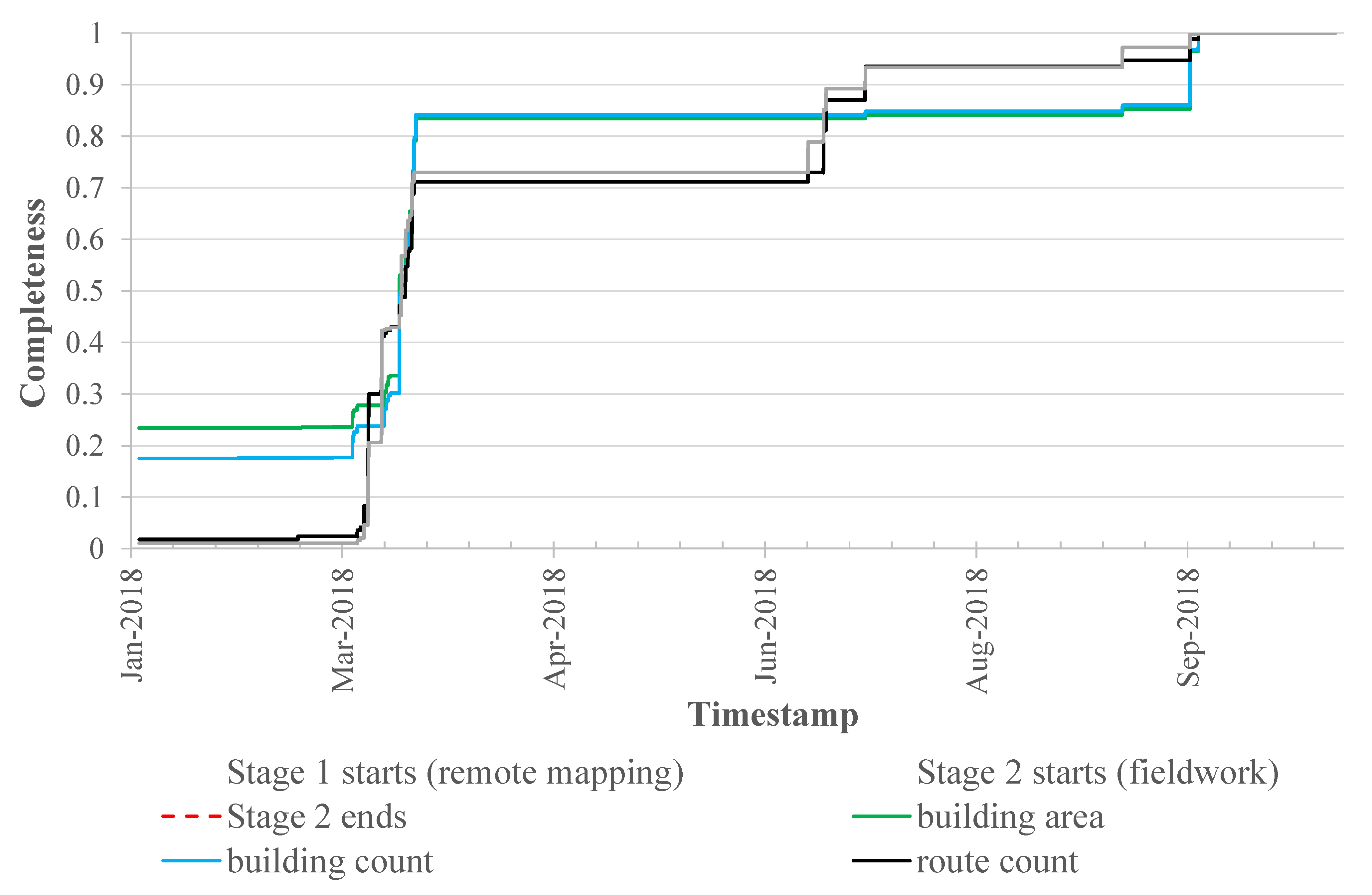




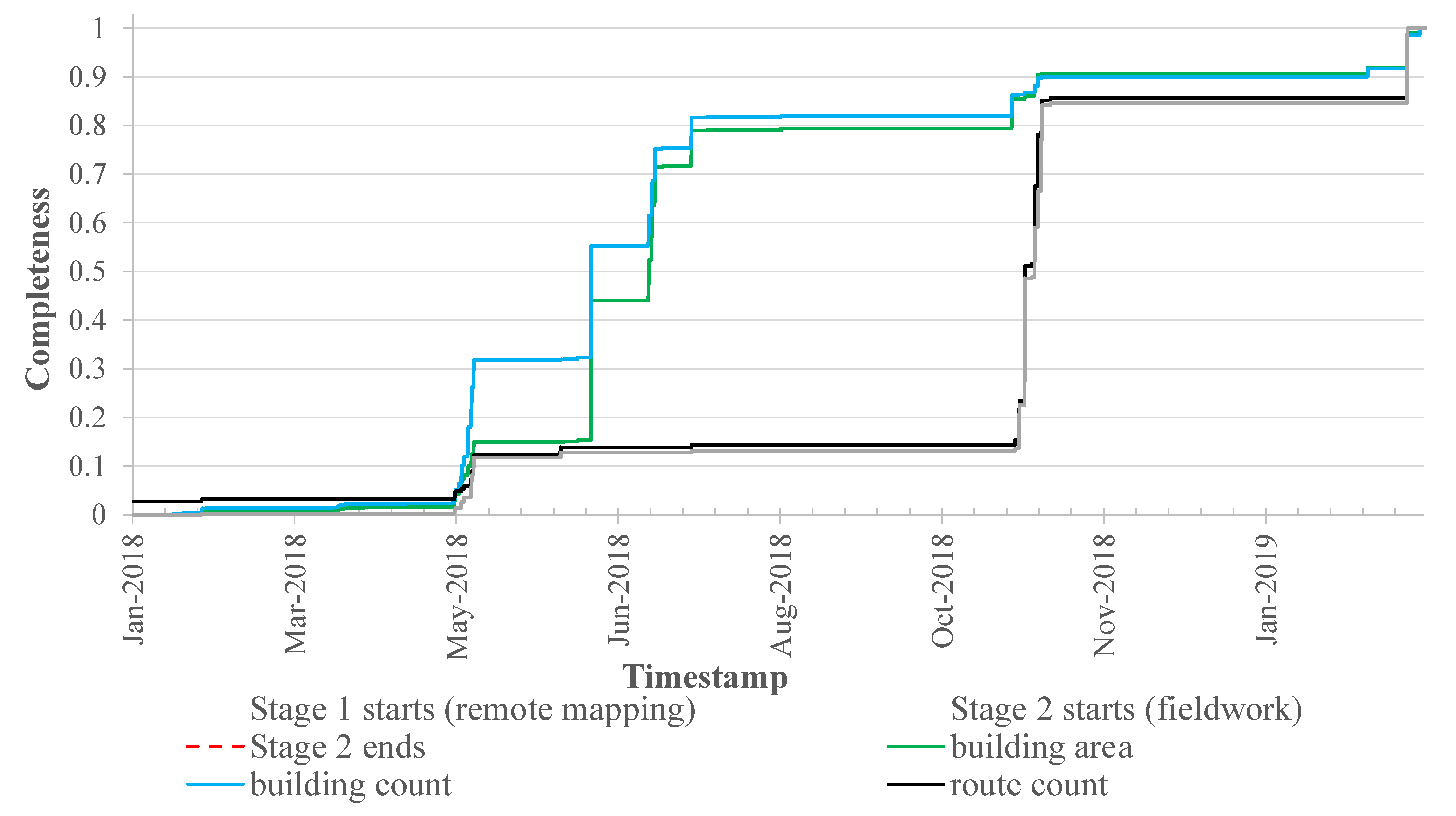
References
- UN-Habitat. UNHABITAT Habitat III Issue Papers-22: Informal Settlements; UN-Habitat: New York, NY, USA, 2015. [Google Scholar]
- Thomson, D.R.; Kuffer, M.; Boo, G.; Hati, B.; Grippa, T.; Elsey, H.; Linard, C.; Mahabir, R.; Kyobutungi, C.; Maviti, J.; et al. Need for an Integrated Deprived Area “Slum” Mapping System (IDEAMAPS) in Low- and Middle-Income Countries (LMICs). Soc. Sci. 2020, 9, 80. [Google Scholar] [CrossRef]
- Kuffer, M.; Pfeffer, K.; Sliuzas, R. Slums from Space—15 Years of Slum Mapping Using Remote Sensing. Remote Sens. 2016, 8, 455. [Google Scholar] [CrossRef]
- Wurm, M.; Taubenböck, H. Detecting Social Groups from Space–Assessment of Remote Sensing-Based Mapped Morphological Slums Using Income Data. Remote Sens. Lett. 2018, 9, 41–50. [Google Scholar] [CrossRef]
- Hachmann, S.; Jokar Arsanjani, J.; Vaz, E. Spatial Data for Slum Upgrading: Volunteered Geographic Information and the Role of Citizen Science. Habitat Int. 2018, 72, 18–26. [Google Scholar] [CrossRef]
- Lilford, R.; Kyobutungi, C.; Ndugwa, R.; Sartori, J.; Watson, S.I.; Sliuzas, R.; Kuffer, M.; Hofer, T.; Albuquerque, J.P.d.; Ezeh, A. Because Space Matters: Conceptual Framework to Help Distinguish Slum from Non-Slum Urban Areas. BMJ Glob. Health 2019, 4, e001267. [Google Scholar] [CrossRef] [PubMed]
- Herfort, B.; Lautenbach, S.; Porto de Albuquerque, J.; Anderson, J.; Zipf, A. The Evolution of Humanitarian Mapping within the OpenStreetMap Community. Sci. Rep. 2021, 11, 3037. [Google Scholar] [CrossRef]
- Missing Maps. Available online: https://www.missingmaps.org/ (accessed on 13 July 2020).
- Barron, C.; Neis, P.; Zipf, A. A Comprehensive Framework for Intrinsic OpenStreetMap Quality Analysis. Trans. GIS 2014, 18, 877–895. [Google Scholar] [CrossRef]
- Sehra, S.S.; Singh, J.; Rai, H.S. Assessing OpenStreetMap Data Using Intrinsic Quality Indicators: An Extension to the QGIS Processing Toolbox. Future Internet 2017, 9, 15. [Google Scholar] [CrossRef]
- Eckle, M.; Albequerque, J.P.d. Quality Assessment of Remote Mapping in OpenStreetMap for Disaster Management Purposes. In Proceedings of the ISCRAM 2015 Conference-Kristiansand, Kristiansand, Norway, 24–27 May 2015; p. 9. [Google Scholar]
- Gröchenig, S.; Brunauer, R.; Rehrl, K. Estimating Completeness of VGI Datasets by Analyzing Community Activity Over Time Periods. In Connecting a Digital Europe Through Location and Place; Huerta, J., Schade, S., Granell, C., Eds.; Springer International Publishing: Cham, Swizterland, 2014; pp. 3–18. ISBN 978-3-319-03611-3. [Google Scholar]
- Barrington-Leigh, C.; Millard-Ball, A. The World’s User-Generated Road Map Is More than 80% Complete. PLoS ONE 2017, 12, e0180698. [Google Scholar] [CrossRef] [PubMed]
- Zhou, Q. Exploring the Relationship between Density and Completeness of Urban Building Data in OpenStreetMap for Quality Estimation. Int. J. Geogr. Inf. Sci. 2018, 32, 257–281. [Google Scholar] [CrossRef]
- Hecht, R.; Kunze, C.; Hahmann, S. Measuring Completeness of Building Footprints in OpenStreetMap over Space and Time. ISPRS Int. J. Geo-Inf. 2013, 2, 1066–1091. [Google Scholar] [CrossRef]
- Minghini, M.; Frassinelli, F. OpenStreetMap History for Intrinsic Quality Assessment: Is OSM up-to-Date? Open Geospat. Data Softw. Stand. 2019, 4, 9. [Google Scholar] [CrossRef]
- Girres, J.-F.; Touya, G. Quality Assessment of the French OpenStreetMap Dataset. Trans. GIS 2010, 14, 435–459. [Google Scholar] [CrossRef]
- Zhang, H.; Malczewski, J. Accuracy Evaluation of the Canadian OpenStreetMap Road Networks. Int. J. Geospat. Environ. Res. 2018, 5, 1–16. [Google Scholar]
- Törnros, T.; Dorn, H.; Hahmann, S.; Zipf, A. Uncertainties of completeness measures in openstreetmap; a case study for buildings in a medium-sized german city. In Proceedings of the ISPRS Annals of Photogrammetry, Remote Sensing and Spatial Information Sciences; Copernicus GmbH: Göttingen, Germany; Volume II-3-W5, pp. 353–357.
- OSMF Board Meeting Minutes 2012-11-03-OpenStreetMap Foundation. Available online: https://wiki.osmfoundation.org/wiki/Board_Meeting_Minutes_2012-11-03 (accessed on 24 November 2020).
- Jacobs, C.; Zipf, A. Completeness of Citizen Science Biodiversity Data from a Volunteered Geographic Information Perspective. Geo-Spatial Inf. Sci. 2017, 20, 3–13. [Google Scholar] [CrossRef]
- Haklay, M. How Good Is Volunteered Geographical Information? A Comparative Study of OpenStreetMap and Ordnance Survey Datasets. Environ. Plann B Plann. Des. 2010, 37, 682–703. [Google Scholar] [CrossRef]
- Lilford, R.J. NIHR Global Health Research Unit on Improving Health in Slums. Available online: https://warwick.ac.uk/fac/sci/med/about/centres/cahrd/slums (accessed on 25 November 2020).
- Guth, J.; Wursthorn, S.; Keller, S. Multi-Parameter Estimation of Average Speed in Road Networks Using Fuzzy Control. ISPRS Int. J. Geo-Inf. 2020, 9, 55. [Google Scholar] [CrossRef]
- Gröchenig, S.; Brunauer, R.; Rehrl, K. Digging into the History of VGI Data-Sets: Results from a Worldwide Study on OpenStreetMap Mapping Activity. J. Locat. Based Serv. 2014, 8, 198–210. [Google Scholar] [CrossRef]
- Oshome OpenStreetMap History Data Analytics Platform. Available online: https://heigit.org/big-spatial-data-analytics-en/ohsome/ (accessed on 8 July 2020).
- OSMstats. Available online: https://osmstats.neis-one.org/ (accessed on 8 July 2020).
- OSM Analytics Tool. Available online: https://osm-analytics.org/#/ (accessed on 8 July 2020).
- Haklay, M.; Basiouka, S.; Antoniou, V.; Ather, A. How Many Volunteers Does It Take to Map an Area Well? The Validity of Linus’ Law to Volunteered Geographic Information. Cartogr. J. 2010, 47, 315–322. [Google Scholar] [CrossRef]
- Mooney, P.; Corcoran, P. Characteristics of Heavily Edited Objects in OpenStreetMap. Future Internet 2012, 4, 285–305. [Google Scholar] [CrossRef]
- Neis, P.; Zielstra, D.; Zipf, A. The Street Network Evolution of Crowdsourced Maps: OpenStreetMap in Germany 2007–2011. Future Internet 2012, 4, 1–21. [Google Scholar] [CrossRef]
- Pourabdollah, A. OSM–GB: Using Open Source Geospatial Tools to Create OSM Web Services for Great Britain. OSGeo J. 2014, 13, 41–50. [Google Scholar]
- Improving Health in Slums Collaborative. A Protocol for a Multi-Site, Spatially-Referenced Household Survey in Slum Settings: Methods for Access, Sampling Frame Construction, Sampling, and Field Data Collection. BMC Med. Res. Methodol. 2019, 19, 109. [Google Scholar] [CrossRef] [PubMed]
- Porto de Albuquerque, J.; Yeboah, G.; Pitidis, V.; Ulbrich, P. Towards a Participatory Methodology for Community Data Generation to Analyse Urban Health Inequalities: A Multi-Country Case Study. In Proceedings of the 52nd Hawaii International Conference on System Sciences, Grand Wailea, HI, USA, 8 January 2019; p. 10. [Google Scholar]
- Albuquerque, J.P.d.; Herfort, B.; Eckle, M. The Tasks of the Crowd: A Typology of Tasks in Geographic Information Crowdsourcing and a Case Study in Humanitarian Mapping. Remote Sens. 2016, 8, 859. [Google Scholar] [CrossRef]
- HOT Tasking Manager. Available online: https://tasks.hotosm.org/ (accessed on 17 September 2020).
- OSMWiki Editors-OpenStreetMap Wiki. Available online: https://wiki.openstreetmap.org/wiki/Editors (accessed on 17 September 2020).
- OpenDataKit Open Data Kit. Available online: https://opendatakit.org/ (accessed on 17 September 2020).
- OpenMapKit OpenMapKit Website. Available online: http://openmapkit.org/ (accessed on 17 September 2020).
- Improving Health in Slums Collaborative. Improving Health in Slums Collaborative Impact of the Societal Response to COVID-19 on Access to Healthcare for Non-COVID-19 Health Issues in Slum Communities of Bangladesh, Kenya, Nigeria and Pakistan: Results of Pre-COVID and COVID-19 Lockdown Stakeholder Engagements. BMJ Glob. Health 2020, 5, e003042. [Google Scholar] [CrossRef]
- Planet_OSM. Available online: https://planet.openstreetmap.org/planet/full-history/ (accessed on 13 November 2020).
- OpenStreetMap Wiki—Planet.Osm/Full. Available online: https://wiki.openstreetmap.org/w/index.php?title=Planet.osm/full&oldid=1661018 (accessed on 13 November 2020).
- Noskov, A.; Grinberger, A.Y.; Papapesios, N.; Rousell, A.; Troilo, R.; Zipf, A. Modelling and Assessing Spatial Big Data: Use Cases of the OpenStreetMap Full-History Dump. In Spatial Planning in the Big Data Revolution; Angioletta, V., La Riccia, L., Eds.; IGI Global: Hershey, PA, USA, 2019; pp. 16–44. ISBN 978-1-5225-7927-4. [Google Scholar]
- Raifer, M.; Troilo, R.; Kowatsch, F.; Auer, M.; Loos, L.; Marx, S.; Przybill, K.; Fendrich, S.; Mocnik, F.-B.; Zipf, A. OSHDB: A Framework for Spatio-Temporal Analysis of OpenStreetMap History Data. Open Geospat. Data Softw. Stand. 2019, 4, 3. [Google Scholar] [CrossRef]
- Troilo, R.; Yeboah, G. Data Extraction Codes for Paper on Gitlab. Available online: https://gitlab.gistools.geog.uni-heidelberg.de/gyrt-share/ijgi-paper (accessed on 26 November 2020).
- Corcoran, P.; Mooney, P.; Bertolotto, M. Analysing the Growth of OpenStreetMap Networks. Spat. Stat. 2013, 3, 21–32. [Google Scholar] [CrossRef]
- International Organization for Standardization. ISO 19157:2013 Geographic Information-Data Quality; International Organization for Standardization: Geneva, Switzerland, 2013. [Google Scholar]
- Soman, S.; Beukes, A.; Nederhood, C.; Marchio, N.; Bettencourt, L.M.A. Worldwide Detection of Informal Settlements via Topological Analysis of Crowdsourced Digital Maps. ISPRS Int. J. Geo-Inf. 2020, 9, 685. [Google Scholar] [CrossRef]
- Yang, A.; Fan, H.; Jing, N. Amateur or Professional: Assessing the Expertise of Major Contributors in OpenStreetMap Based on Contributing Behaviors. ISPRS Int. J. Geo-Inf. 2016, 5, 21. [Google Scholar] [CrossRef]




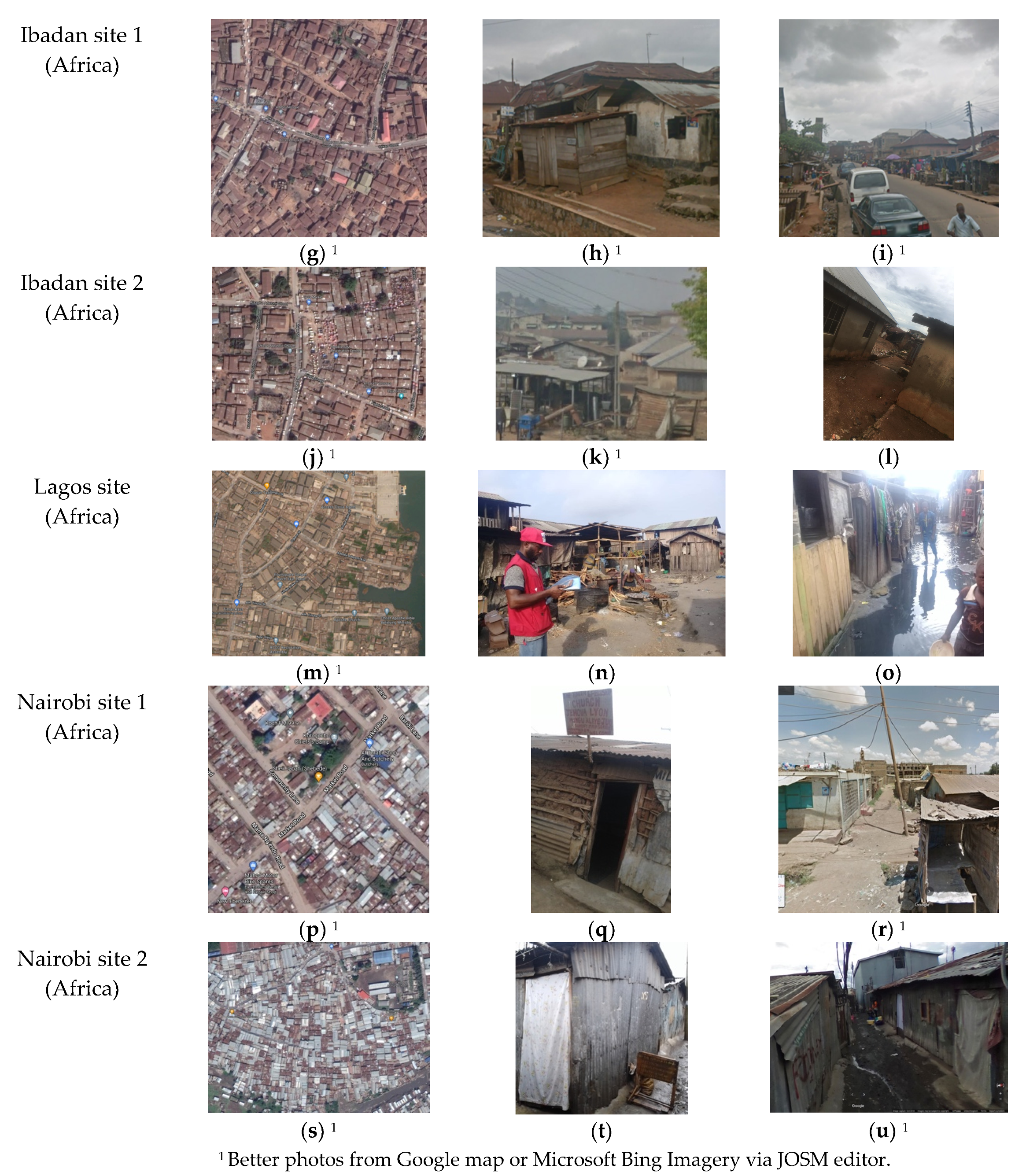
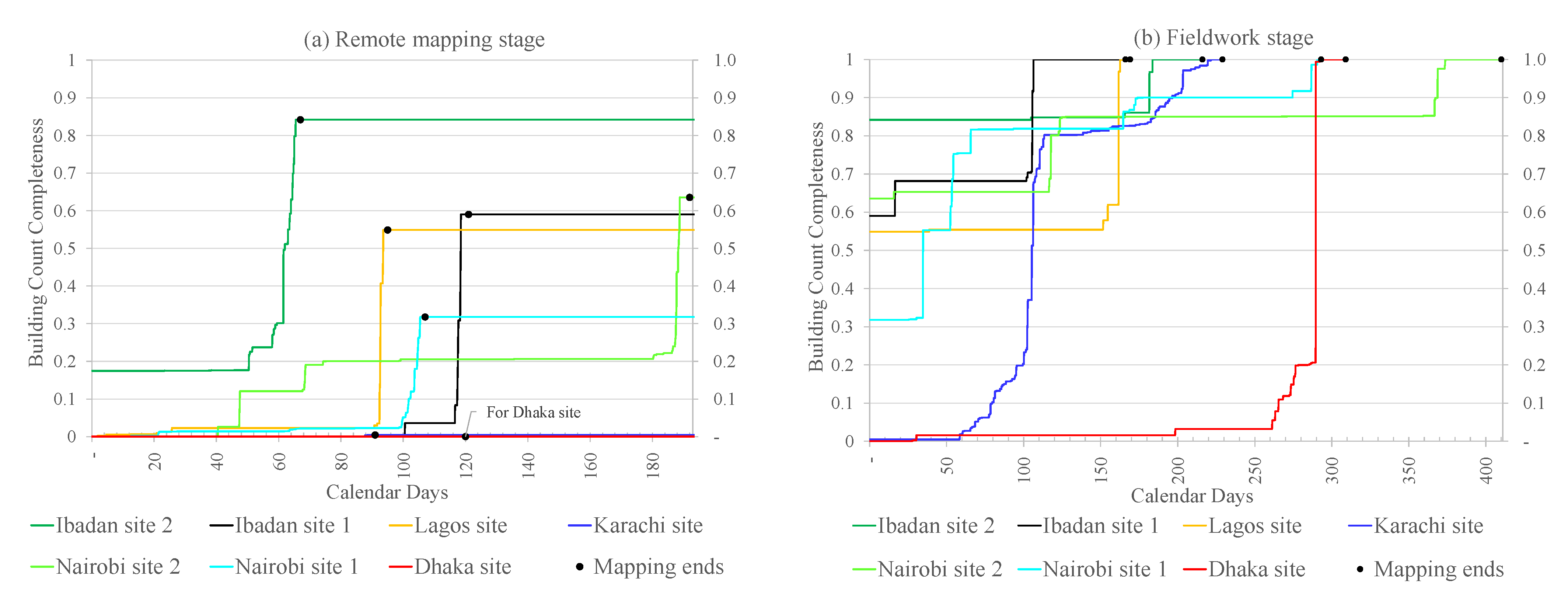




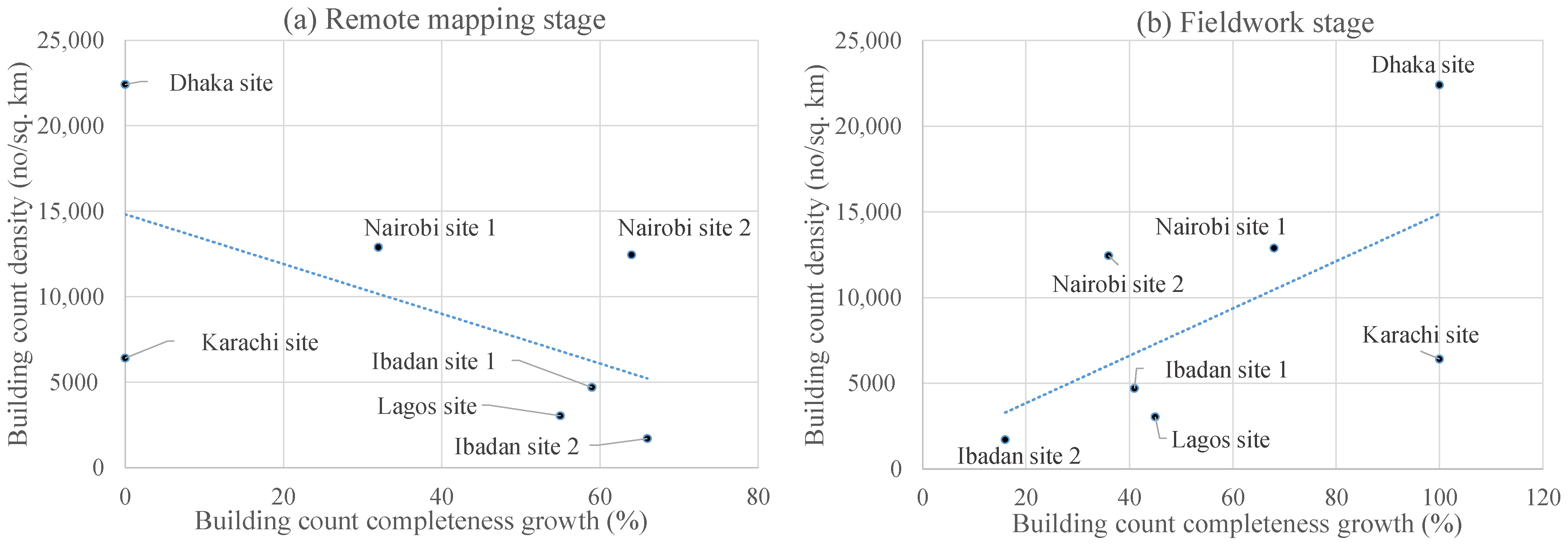

| Main Steps | Brief Description |
|---|---|
| Preparation | Preparing materials, engaging stakeholders, and defining responsibilities for the subsequent steps. This involves clarifying who the persons are that will fulfil the roles for each local partner team, as well as preparing materials for the digitization and mapping phases. |
| Digitization | To produce detailed base maps of the slum locations by tracing all streets and building structures from high-resolution optical satellite imagery. It involves digitization by remote and local teams and validation by experts. |
| Participatory mapping | To validate and enrich the digital maps obtained in the previous steps with the local communities by correcting potential inaccuracies and, most importantly, conflating the map with local knowledge of residents. |
| Analysis | To consolidate the geospatial data obtained in the previous steps into data products and visualizations that will be useful for end-users and researchers. |
| Site (Country) | Overall Total | Stage 1 Mappers | Stage 2 Mappers | Area | No. of Buildings (Routes) |
|---|---|---|---|---|---|
| Building (Route) | Building (Route) | Building (Route) | Sq. km | ||
| Karachi site (Pakistan) | 24 (18) | 17 (22) | 10 (12) | 0.4 | 2566 (150) |
| Ibadan site 1 (Nigeria) | 14 (19) | 13 (18) | 7 (11) | 0.4 | 1882 (105) |
| Ibadan site 2 (Nigeria) | 17 (16) | 11 (13) | 15 (14) | 1.2 | 2047 (170) |
| Lagos site (Nigeria) | 15 (20) | 15 (16) | 11 (15) | 0.3 | 911 (51) |
| Dhaka site (Bangladesh) | 21 (14) | 17 (10) | 20 (12) | 0.3 | 6722 (163) |
| Nairobi site 1 (Kenya) | 44 (37) | 39 (33) | 31 (27) | 0.5 | 6444 (188) |
| Nairobi site 2 (Kenya) | 53 (28) | 49 (24) | 33 (18) | 0.6 | 7470 (73) |
| Site (sq. km) | Stage 1 Completeness Growth in % | Stage 2 Completeness Growth in % | Final Density (no./sq. km) | |||
|---|---|---|---|---|---|---|
| Building Count (Area) | Route Count (Length) | Building Count (Area) | Route Count (Length) | Building | Route | |
| Karachi site (0.4) | 0 (0) | 7 (10) | 100 (100) | 93 (90) | 6415 | 375 |
| Ibadan site 1 (0.4) | 59 (51) | 8 (1) | 41 (49) | 92 (99) | 4705 | 263 |
| Ibadan site 2 (1.2) | 66 (60) | 70 (72) | 16 (16) | 30 (28) | 1706 | 142 |
| Lagos site (0.3) | 55 (30) | 37 (29) | 45 (70) | 63 (71) | 3037 | 170 |
| Dhaka site (0.3) | 0 (0) | 39 (33) | 100 (100) | 61 (67) | 22,407 | 543 |
| Nairobi site 1 (0.5) | 32 (15) | 9 (12) | 68 (85) | 88 (88) | 12,888 | 376 |
| Nairobi site 2 (0.6) | 64 (64) | 1(0) | 36 (36) | 96 (100) | 12,450 | 122 |
| Site | Stage 1 Completeness Growth per Mapper in % | Stage 2 Completeness Growth per Mapper in % | ||
|---|---|---|---|---|
| Building Count (Area) | Route Count (Length) | Building Count (Area) | RouteCount (Length) | |
| Karachi site | 0.0 (0.0) | 0.3 (0.5) | 10 (10) | 7.8 (7.5) |
| Ibadan site 1 | 4.5 (3.9) | 0.4 (0.1) | 5.9 (7.0) | 8.4 (9.0) |
| Ibadan site 2 | 6.0 (5.5) | 5.4 (5.5) | 1.1 (1.1) | 2.1 (2.0) |
| Lagos site | 3.7 (2.0) | 2.3 (1.8) | 4.1 (6.4) | 4.2 (4.7) |
| Dhaka site | 0.0 (0.0) | 3.9 (3.3) | 5.0 (5.0) | 5.1 (5.6) |
| Nairobi site 1 | 0.8 (0.4) | 0.3 (0.4) | 2.2 (2.7) | 3.3 (3.3) |
| Nairobi site 2 | 1.3 (1.3) | 0.0 (0.0) | 1.1 (1.1) | 5.3 (5.6) |
Publisher’s Note: MDPI stays neutral with regard to jurisdictional claims in published maps and institutional affiliations. |
© 2021 by the authors. Licensee MDPI, Basel, Switzerland. This article is an open access article distributed under the terms and conditions of the Creative Commons Attribution (CC BY) license (https://creativecommons.org/licenses/by/4.0/).
Share and Cite
Yeboah, G.; Porto de Albuquerque, J.; Troilo, R.; Tregonning, G.; Perera, S.; Ahmed, S.A.K.S.; Ajisola, M.; Alam, O.; Aujla, N.; Azam, S.I.; et al. Analysis of OpenStreetMap Data Quality at Different Stages of a Participatory Mapping Process: Evidence from Slums in Africa and Asia. ISPRS Int. J. Geo-Inf. 2021, 10, 265. https://doi.org/10.3390/ijgi10040265
Yeboah G, Porto de Albuquerque J, Troilo R, Tregonning G, Perera S, Ahmed SAKS, Ajisola M, Alam O, Aujla N, Azam SI, et al. Analysis of OpenStreetMap Data Quality at Different Stages of a Participatory Mapping Process: Evidence from Slums in Africa and Asia. ISPRS International Journal of Geo-Information. 2021; 10(4):265. https://doi.org/10.3390/ijgi10040265
Chicago/Turabian StyleYeboah, Godwin, João Porto de Albuquerque, Rafael Troilo, Grant Tregonning, Shanaka Perera, Syed A. K. Shifat Ahmed, Motunrayo Ajisola, Ornob Alam, Navneet Aujla, Syed Iqbal Azam, and et al. 2021. "Analysis of OpenStreetMap Data Quality at Different Stages of a Participatory Mapping Process: Evidence from Slums in Africa and Asia" ISPRS International Journal of Geo-Information 10, no. 4: 265. https://doi.org/10.3390/ijgi10040265
APA StyleYeboah, G., Porto de Albuquerque, J., Troilo, R., Tregonning, G., Perera, S., Ahmed, S. A. K. S., Ajisola, M., Alam, O., Aujla, N., Azam, S. I., Azeem, K., Bakibinga, P., Chen, Y.-F., Choudhury, N. N., Diggle, P. J., Fayehun, O., Gill, P., Griffiths, F., Harris, B., ... Yusuf, R. (2021). Analysis of OpenStreetMap Data Quality at Different Stages of a Participatory Mapping Process: Evidence from Slums in Africa and Asia. ISPRS International Journal of Geo-Information, 10(4), 265. https://doi.org/10.3390/ijgi10040265








